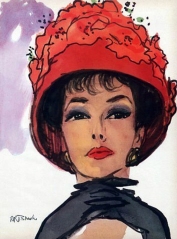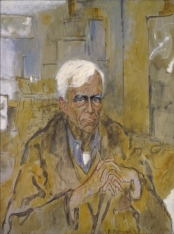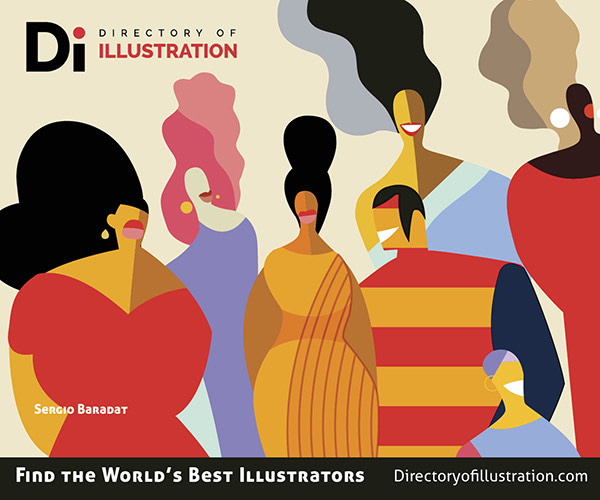
The above image is a poster for a 1974 exhibit of Rene Bouche’s artwork at the Parsons School of Design in New York City.

Rene Bouche (1905-1963) was born Robert August Buchstein in Austro-Hungarian Prague. When he was 21 years old he studied art history at Munich University and in 1927 moved to Berlin where he became a professional illustrator and met his first wife. In the 1930’s, shortly after Hitler came to power, Bouche left for Paris where he studied at the Academie Ozenfant.
In 1938 Bouche contributed his first illustration to Vogue Magazine, a relationship that continued for the rest of his life. He quickly became one of the top fashion illustrators in the business.


The way Bouche posed his figures, and the expressions he gave them, has a certain “attitude” that worked well in the fashion world.
For example, take a look at the four figures in this article about furs. The first woman is shown from a back view with her head titled up as if she has an air of confidence to her. The next figure is looking downward and it feels like she’s striking a pose to show off her coat. After that the third figure is looking right at us with one hand on her hips, which are at an angle. She also feels like a confident woman showcasing her outfit. The final figure is a seated woman looking off to the side much like the second figure. That, along with her right arm leaning on the chair, gives her a sense of confidence.

What I also like about Bouche’s fashion illustrations is his selectivity and the way he simplified his images. In the illustration below take a look at the background. Bouche used only a few pen marks to depicted the park and the buildings. There’s enough in it to suggest the park and that’s all you really need to understand it as a viewer. This approach gives his drawings a sense of ease to them (not to be confused with being easy to do!) and it doesn’t weight you down with lots of realistic details. It makes you focus on the two women, which is the most important element in the composition.

The image below is another example of his selectivity. Bouche drew just enough details to show these women putting on makeup. He didn’t close the shape of their head, draw their hair or even put in their shoulders. It’s simply their facial features, hands and the makeup. As a viewer you know right away what the illustration is depicting.

This approach also lends itself to a certain style that doesn’t always rely on a realistic interpretation. At times the drawings might even be “off”, yet the overall feeling of the image works for what he’s trying to depict. It reminds me of the way someone writes his or her signature. In Bouche’s case you could call it his “signature look”. Ha!
Here’s a gallery of fashion illustration that he did for Vogue:




















While in France, Bouche was separated from his wife and son and forced to escape due to German forces that were advancing. He made his way to Cassis-sure-mer and then eventually to Lisbon. From there he left for the United States on what was one of the last boats to cross the Atlantic Ocean before Pearl Harbor. In the United states he gained citizenship and continued to work for Vogue while also doing illustrations for advertising clients such as Elizabeth Arden.



In addition to his illustrations he was also a painter and in the late 40’s was inspired by abstract expressionism, joining The Eight Street Avant-Garde Painters Club. He exhibited a series of abstract work in 1951 at Tibor de Nagy Gallery.


A few years later he turned his attention back to the figure and more specifically portrait painting. Bouche talked about this period of his work:
“I must say, I think I was one of the very, very first to be interested again in the figure. Mind you, I have nothing against abstract art; I was abstract until 1951 or 1952. But I began to thirst for the human image. And no one else was doing portraits, you know, it was very iconoclastic. Abstract art is, after all, about a half century old. It has emancipated painting beautifully, though it hasn’t added a great deal – oh, a certain lightness, a certain airiness, yes – but nothing too terribly new. But I felt that fusing abstract techniques to portraiture could produce a real internal likeness. The portrait flourishes only in a renaissance of nature and culture. It takes a proud, sure person to understand that his value of himself is perfectly desirable. The Modern is confirming a new wind with the figure show, and my painting of Elsa Maxell will hang there. Painting this picture, I was moved by the convinced thrust of a forceful character mixed with a groping seriousness. This tension spells beauty to me.”
Here’s his painting of Elsa Maxwell:

He also did a painting of the sculptor Alexander Calder.

Who you can see here posed next to the piece.

Other portraits include George Braque, Lady Hartwell, Lady Anne Glenconner, Leonard Bernstein and many more.




In the May 19th, 1961 issue of LOOK Magazine they wrote an article about Bouche and the process he went through to do a painting of an actress named Tammy Grimes.



Bouche was also hired by commercial illustration clients for portrait work. TV Guide commissioned him to do a cover illustration of Judy Garland

Who he captured in a drawing while she was taking a break.

CBS hired him to draw Frank Sinatra and Edward R Murrow.


In the 1960’s TIME Magazine hired him to do a series of covers including John F. Kennedy, Teddy Kennedy, Sophia Loren, and Jean Kerr.




Bouche is an artist worth highlighting today because he was always pushing himself and worked in a variety of fields…portrait painting, abstract expressionism, editorial and fashion illustration. I think its important to show what came before, especially fashion illustration which is no longer the same today (when is the last time Vogue Magazine published a fashion illustration?).
Artists like Bouche give you an idea about the world he lived in and the possibilities that fashion had during his lifetime. I know time has changed, but I still think that, with the right artist and client, you could do a similar approach for a magazine or advertisement.
On July 3rd, 1963 Rene Bouche died unexpectedly of a heart attack at the age of 57 years old.










It is always interesting to see how illustration changes with time. I wonder, what will happen in the next 100 years!… 🤭
Thaank you